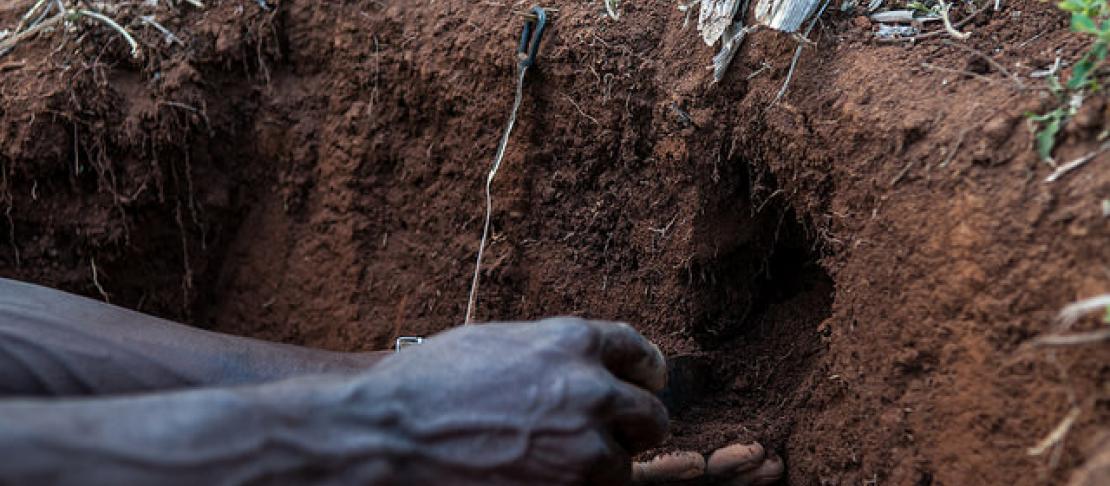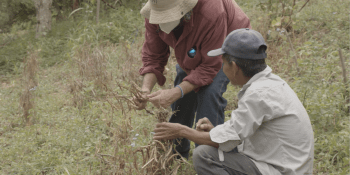Book and videos explain how to measure soil carbon, greenhouse gas emissions and analyze mitigation options in smallholder farming

Guidelines for measurement of agricultural emissions and mitigation potential may fill large gap in comparable data from smallholder farms in developing countries.
Data on greenhouse gas emissions from smallholder farming are scant and often not comparable across systems, countries, or regions. Without reliable and accurate smallholder farming data, it will be very difficult for countries to contribute to the Paris Agreement or other climate change mitigation actions.
To rapidly expand the amount of reliable data from smallholder farms in developing countries, scientists founded SAMPLES, a global research program that supports tropical countries to measure greenhouse gas emissions from agriculture and identify mitigation options compatible with food security. Under the auspices of SAMPLES, CGIAR scientists, partners at the Food and Agriculture Organization of the United Nations (FAO), the Global Research Alliance on Agricultural Greenhouse Gases (GRA) and dozens of other research scientists published the open-access book titled Methods for Measuring Greenhouse Gas Balances and Evaluating Mitigation Options in Smallholder Agriculture in 2016.
Intended to make rigorous measurement of agricultural emissions and climate change mitigation accessible and feasible to conduct in in tropical, developing countries, the book explains how to design a measurement program; acquire data in the areas of land use and land cover change; soil emissions, enteric methane emissions from livestock, soil emission, tree biomass carbon, soil organic carbon, and yield estimation; and identify mitigation options through explaining how to scale point measurements to farms and landscapes, and conduct a trade-off analysis. Videos developed by or in collaboration with authors now accompany two chapters.
Measuring soil carbon in Ghana
As research and expectations mount around the potential impact of sequestering soil carbon on climate change mitigation, the need for robust, reliable data on soil carbon stocks and stock changes on farms in differing landscapes is critical. Gustavo Saiz, of Imperial College London and lead author of the chapter “Methods for smallholder quantification of soil carbon stocks and stock changes,” worked with colleagues at CCAFS, Alain Albrecht and Tiphaine Chevallier of the French National Research Institute for Sustainable Development (IRD), and Ghana’s Kwame Nkumah University of Science and Technology (KNUST), to show how scientists measure soil organic carbon stocks on smallholder farms in Ghana. The video embedded below is in English. Click here to see the French.
Video: Measuring soil organic carbon on smallholder farms
Read more about the potential of soil carbon at the 4per1000 Initiative, Soils for Food Security and Climate.
Methodology for quantifying soil greenhouse gas emissions, fluxes
Chapter co-authors focus on the chamber methodology for measuring emissions from soils because it is best adapted to tropical, developing countries. In the video, they discuss chamber placement considerations, gas sampling method, and how to conduct analyses and process data. They also make recommendations based on recent scientific findings, including how to address spatial and temporal variability and use the gas pooling technique.
Video: Quantifying greenhouse gas emissions from managed and natural soils
How to use this information
As countries move toward implementation of the Paris Agreement, the book is designed to provide needed guidance on measurement methods to:
- National agricultural research centers (NARS)
- Compilers of national GHG inventories
- Developers of national and subnational mitigation plans that include agriculture
And as the private sector and development organizations also innovate to decrease net emissions, and contribute to or benefit from climate finance, agricultural commodity companies and agricultural development projects will also find these methods accessible and feasible.
Finally, the book and accompanying videos are appropriate texts for university and graduate instructors and students in agriculture and climate change.
“This book – and the accompanying videos – could be helpful for a potentially very large number of people. This is science with a purpose.” Gustavo Saiz
Further reading and viewing
- Video: Measuring soil organic carbon on smallholder farms / Mesurer le carbone des sols en parcelle paysanne
- Video: Quantifying greenhouse gas emissions from managed and natural soils
- Website: SAMPLES
- Rosenstock TS, Rufino MC, Butterbach-Bahl K, Wollenberg E, Richards MB (eds). 2016. Methods for Measuring Greenhouse Gas Balances and Evaluating Mitigation Options in Smallholder Agriculture. New York: Springer.
- Vermeulen S, Wollenberg E. 2017. A rough estimate of the proportion of global emissions from agriculture due to smallholders. CCAFS Info Note.
- Additional soil carbon videos based on IRD research on soil carbon in Madagascar, Senegal, and Togo (in French with English subtitles).
Julianna White is the program manager for CCAFS Low Emissions Development research.



